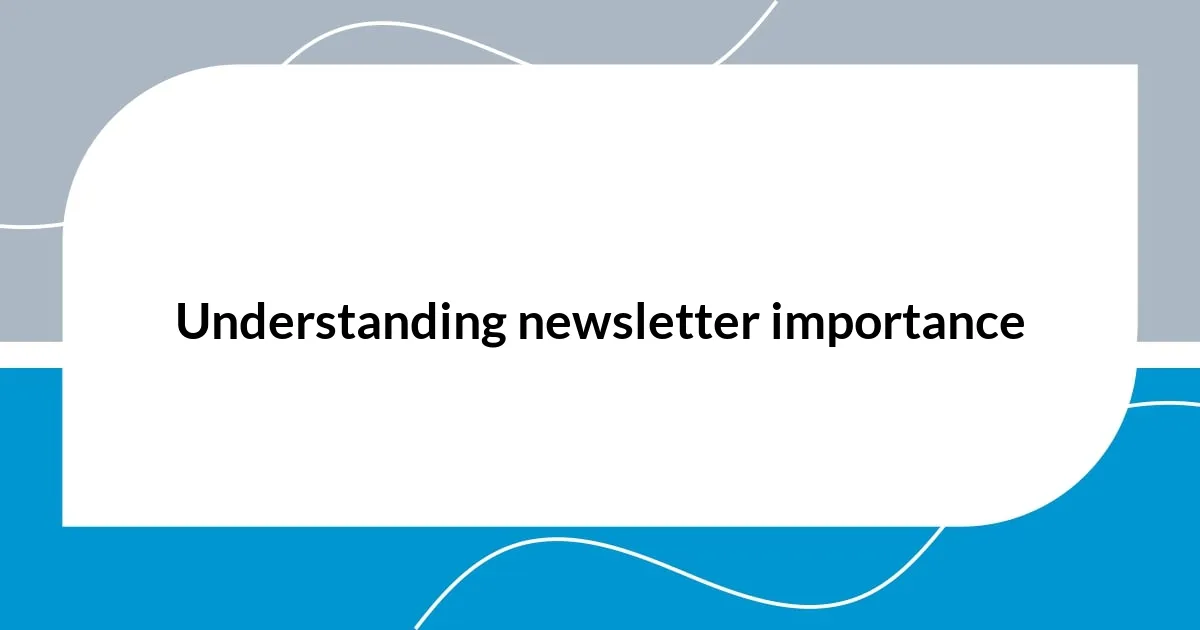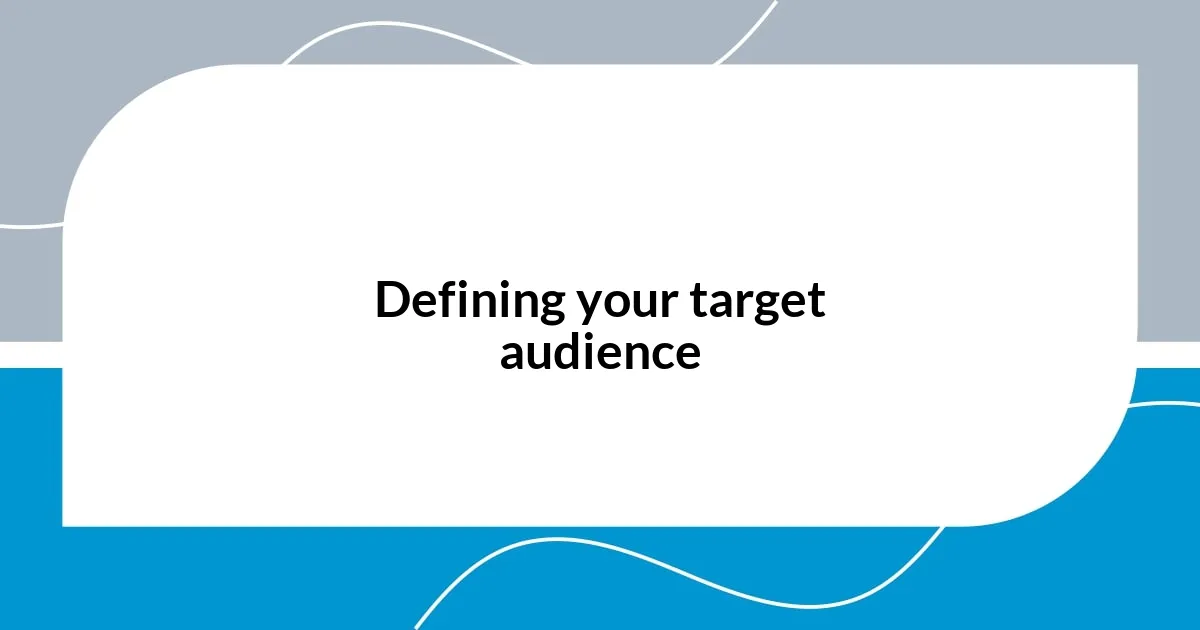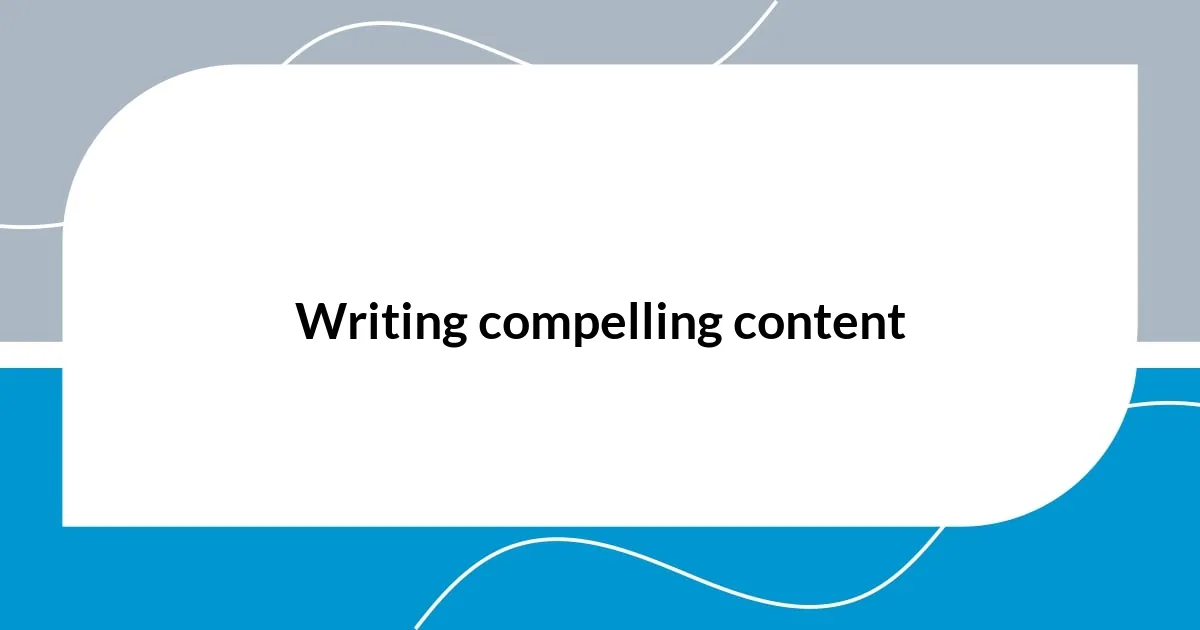Key takeaways:
- Newsletters create a sense of community and provide curated content that helps readers navigate information overload.
- Defining the target audience through demographics, interests, and challenges is crucial for crafting engaging newsletters.
- Engaging subject lines and visually appealing layouts significantly impact open rates and reader engagement.
- Establishing a consistent schedule and measuring success through engagement metrics helps in optimizing newsletter strategies over time.

Understanding newsletter importance
Newsletters hold a unique position in my information diet, serving as a reliable source of curated content. I remember the launch of a particular newsletter that focused on my hobbies; it felt like finding a treasure chest of ideas tailored just for me. Each issue was a little thrill, bringing fresh insights and sparking inspiration in unexpected ways.
What struck me as essential about newsletters is their ability to foster a sense of community. When I would receive updates from a favorite author or brand, it felt like an invitation to join a conversation—one where I wasn’t just a passive recipient. Have you ever felt that warmth when a newsletter feels like a handwritten letter from a friend? It’s a powerful connection that makes the information feel all the more valuable.
Moreover, newsletters often serve as a grounding point in the chaos of online content. In an age where information overload can lead to paralysis, I find reassurance in the simplicity of a well-crafted newsletter. It’s like that constant friend who offers wisdom and guidance, stripping away the noise and presenting what truly matters in a digestible format. How often do you find yourself wishing for a little clarity in a cluttered world? That’s the magic a thoughtfully designed newsletter can deliver.

Defining your target audience
Defining your target audience is crucial for creating a newsletter that resonates. I remember launching a newsletter aimed at fellow fitness enthusiasts, and the moment I realized my audience was not just gym-goers but also those seeking holistic wellness—it changed everything. Tailoring content to meet their diverse interests improved engagement and made my efforts feel meaningful. It’s about digging deeper into who your readers are and what they genuinely want to learn.
To effectively define your target audience, consider the following aspects:
- Demographics: Age, gender, location, and income can shape content preferences.
- Interests: Identifying specific hobbies or passions helps in creating targeted topics.
- Challenges: Understanding pain points allows for content that addresses real needs.
- Engagement Patterns: Analyze how your audience interacts with existing newsletters and content.
- Feedback: Encourage direct input from readers to refine your understanding.
By considering these factors, you can craft newsletters that feel personally curated, creating a stronger bond with your audience.

Crafting engaging subject lines
Crafting engaging subject lines is pivotal to the success of a newsletter. I recall the excitement I felt when I received an email with a subject line that piqued my curiosity. It read, “Unlock the Secrets of Urban Gardening Today!” That single phrase pulled me in—anything that promises to unlock secrets has my attention. It’s imperative to think about how a subject line sets the stage for your content.
Moreover, I’ve learned through experience that simplicity often trumps complexity. A straightforward subject line like “5 Easy Ways to Boost Your Productivity” has a clarity that is hard to resist. Readers want to know what’s in it for them before they even open the email. Balancing compelling language with clear value is a sweet spot I strive for in each newsletter. What if a subject line is too vague? There’s a strong chance it will be ignored.
When experimenting with subject lines, testing different formats can yield surprising results. From using emojis to creating a sense of urgency, I once tested variations like “Last Chance to Save on Your Favorite Courses!” versus “Don’t Miss Out!” The former generated significantly more opens because it felt IRREPLACEABLE. Each choice in wording can make a significant impact on open rates, helping me understand my audience’s preferences better.
| Technique | Description |
|---|---|
| Curiosity-Piquing Questions | Encourages readers to find answers inside the newsletter. |
| Simplicity and Clarity | Direct and straightforward lines that communicate value quickly. |
| Limited-Time Offers | Creates urgency, prompting immediate action from readers. |
| Personalization | Using the recipient’s name or preferences enhances engagement. |

Designing visually appealing layouts
Designing visually appealing layouts can make or break a newsletter. I remember when I first started using grid layouts; the difference was striking. Suddenly, my content felt organized and inviting, rather than a jumbled mass of text. A well-structured layout not only captivates readers but also enhances readability. Have you ever felt overwhelmed by a cluttered email? That’s why simplicity is key—less often leads to more in terms of engagement.
Color schemes play a vital role in maintaining reader interest. I experimented with different palettes until I settled on a combination that resonated with my audience’s vibe. Using contrasting colors for text and backgrounds can really make your key messages pop! But don’t go overboard; too many colors can be distracting instead of appealing. When I switched to a cohesive, soft-toned palette, my reader’s feedback reflected their newfound comfort with my newsletters.
Imagery is another crucial element that shouldn’t be overlooked. Personally, I once included photos that were relevant yet high-quality, and I could see the positive impact right away. Those striking visuals drew readers in, encouraging them to engage with the content. It’s like inviting someone over for dinner; a beautifully set table makes all the difference. Have you thought about the images you use? They can serve as powerful storytellers that enhance the overall experience of your newsletter.

Writing compelling content
Writing compelling content goes beyond simply putting words on a page; it’s about creating a connection with your audience. I once wrote an article that resonated deeply with my readers because it felt personal. I shared a moment of vulnerability that many could relate to, and the responses were overwhelming. People crave authenticity; they want to feel like you’re speaking directly to them, sharing insights that resonate with their own experiences. Have you considered how sharing your own journey can impact your audience?
In my experience, storytelling is a powerful tool in crafting newsletter content. I remember incorporating a story about a small business that overcame obstacles to flourish, which captivated my readers. It’s fascinating how a well-told tale can evoke emotions and inspire action, prompting readers to think, “If they can do it, so can I!” When you weave a narrative into your messages, you create a memorable experience that stands out in a sea of information. How can you use stories to make your content more engaging?
Furthermore, focusing on reader benefits is essential. I’ve found that when I highlight what the reader will gain from the content upfront, the engagement rates skyrocket. For instance, rather than just discussing a new technique, I emphasize how it transformed my productivity and brought tangible results. It’s like asking them, “What’s in it for you?” and then answering that question clearly. Realizing that I could make my readers’ lives easier or more enjoyable through concise and relevant information was a game changer for me, and it could be for you too!

Establishing a consistent schedule
One of the best decisions I made for my newsletters was establishing a consistent schedule. Initially, I would send them out whenever I felt like it, but that was a recipe for chaos. Once I committed to a regular rhythm—weekly on Thursdays—my readers began to anticipate my content, and I noticed a significant boost in open rates. Have you ever found yourself eager for a favorite show’s next episode? It’s that same feeling of excitement and expectation that I now see with my audience.
I also learned that timing is everything. When I researched my audience’s habits, I discovered the best times to send my newsletters to maximize engagement. I remember the thrill of realizing my readers were most active right after lunch; it transformed my sending strategy. Since then, I’ve always made sure to hit “send” just before that sweet spot. What timing works best for you? It can be the difference between an unread email and a lively conversation.
Finally, sticking to a schedule allowed me to develop a flow in my content creation process. I set aside specific days for brainstorming, writing, and editing. This structure helped me maintain high quality, as I wasn’t rushed or scrambling at the last minute. It’s empowering, really—knowing when each phase of the newsletter will take place. Have you tried mapping out your own process? It might surprise you how much smoother things can run when you hold yourself to a consistent timeline.

Measuring success and optimizing strategy
Measuring success in my newsletters has been a revelation. Initially, I only glanced at open rates, but soon realized the real treasure lay in reader engagement metrics like click-through rates and responses. It felt like piecing together a puzzle; every click was a sign that my content resonated. Have you ever noticed how a small change can lead to a big difference in the way your readers interact with your content?
As I started to gather data, I found patterns emerging that helped me optimize my content strategy. For instance, I discovered that polls or questions at the end of my newsletters consistently sparked conversations. By adapting based on feedback, not only did I see increased engagement, but it also created a more vibrant community around my newsletters. Have you ever thought about how your audience can shape the content you create?
In one memorable instance, I tweaked my subject lines after analyzing which ones led to the highest open rates. I took a more playful approach, and it was thrilling to witness a marked increase in engagement—almost a 25% boost overnight! That moment reinforced my belief that measuring success is an ongoing journey. It’s not just about data; it’s about nurturing relationships and continuously evolving. How responsive are you to the feedback and data your own newsletters generate?